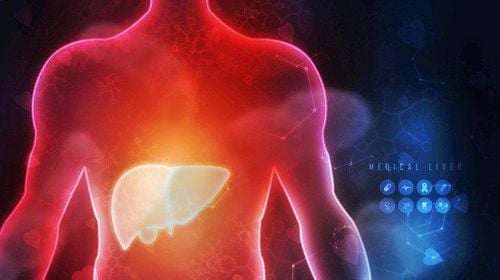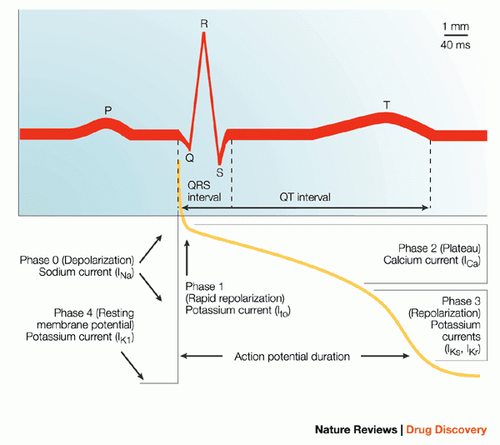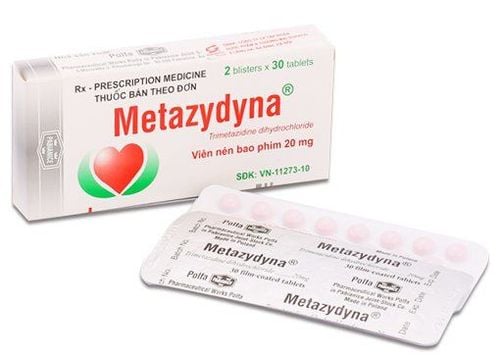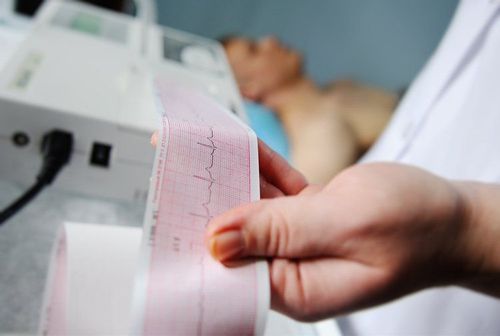This is an automatically translated article.
Article by Doctor Dao Kim Phuong - Department of Medical Examination - Vinmec Times City International General Hospital.
Acquired long QT syndrome is a cardiac repolarization disorder characterized by a prolongation of the QT interval on the electrocardiogram due to acquired etiology. This is often caused by drug and electrolyte abnormalities that can trigger torsades de pointes ventricular arrhythmias.
1. Overview
Acquired long QT syndrome is a cardiac repolarization disorder characterized by a prolongation of the QT interval on the electrocardiogram due to acquired etiology. This is often caused by drug and electrolyte abnormalities that can trigger torsades de pointes ventricular arrhythmias.
Torsade de pointes is a form of polymorphic ventricular tachycardia (VT) characterized by twisting of QRS complexes around an isoelectric line in a sinusoidal pattern that is usually self-limiting but can degenerate into ventricular fibrillation .
Long QT syndrome can lead to some serious and possibly fatal arrhythmias.
2. Overall rating
Diagnosis is made with a resting electrocardiogram (ECG) showing a prolonged corrected QT interval (QTc).
For men:
A proximal QTc interval defined as 430-450 milliseconds A protracted QTc interval defined as > 450 milliseconds For women:
A proximal QTc interval prolongation defined is 450-470 milliseconds A prolonged QTc interval can be defined as > 470 milliseconds or > 460 milliseconds (according to Circulation 2017 Nov 7;136(19):e273) Causes of acquired long QT syndrome include include many drugs and electrolyte abnormalities:
Certain antiarrhythmic drugs (such as dofetilide, ibutilide, sotalol, disopyramide, procainamide, and quinidine) Certain anti-infectives: clarithromycin, azithromycin, erythromycin, halofantrine, pentamidine, sparfloxacin, chloroquine, fluoroquinolones Certain antipsychotics: chlorpromazine, haloperidol, mesoridazine, thioridazine, pimozide, butyrophenone, phenothiazines Some antiemetics and allergy drugs: domperidone, droperidol, astemizole, terfenadine, loperamide abuse

3. Epidemiology
In general, women are affected 2 or 3 times more than men.
Incidence:
The incidence of acquired long QT syndrome is difficult to estimate. Significant QT prolongation has been reported in:
1% -10% of patients taking antiarrhythmic drugs that prolong the QT interval Less than 1% of patients taking other drugs with a potential for QT prolongation
4. Risk factors
Clinical risk factors:
Comorbid cardiac conditions, such as ventricular arrhythmias, bradycardia, recent conversion from atrial fibrillation, left ventricular hypertrophy, myocardial ischemia, hypertension, heart failure with reduced ejection fraction Electrolyte abnormalities include: hypokalemia, hypotension, hypocalcemia Female sex Diabetes increased body mass index Increased serum cholesterol Levels of thyroid hormones Hyperthyroidism Hypothyroidism Hypothermia Organ failure in patients treated with QT-prolonging drugs requires elimination/metabolism in dysfunctional organs, such as: + Renal failure in patients receiving treatment treatment with a QT-prolonging drug that requires renal elimination (e.g. sotalol)
+ Liver failure in patients treated with a QT-prolonging drug requiring hepatic metabolism for clearance (e.g. methadone)
+ Vomiting or diarrhea lead to electrolyte disturbances that increase the QT-prolonging effect of drugs (such as antiemetics or antibiotics)
Genetic susceptibility Pharmacodynamic mechanisms ge n-drugs (due to genetic variants) may enhance the QT-prolonging effects of drugs. Ion channel polymorphisms

5. Risk factors for torsades de pointes
Elderly Gender Female Heart condition: left ventricular hypertrophy, decreased left ventricular ejection fraction, myocardial ischemia Arrhythmia: sinus arrest after conversion from fibrillation/atrial flutter to sinus rhythm, compensatory rest after premature ventricular premature beats (PVCs), sinus arrest, Mobitz II, or complete atrioventricular (AV) block with ventricular rate < 40 beats/min Electrolyte abnormalities: hypokalemia (moderate to severe), hypomagnesaemia (moderate to severe), electrolyte disturbances malnutrition Metabolic impairment (acquired or inherited): renal failure, liver failure Genetic predisposition to QT prolongation Personal or family history of unexplained QT prolongation Family history of syncope, sudden death, or congenital long QT syndrome Concomitant use of QT-prolonging drugs or impaired metabolism of QT-prolonging drugs
6. Clinical Manifestations
Random electrocardiogram (ECG) findings in asymptomatic patients
Initial clinical manifestations may include
Palpitations Previous syncope or syncope Sudden cardiac death or sudden cardiac arrest Lightheadedness Breathing Dizziness Chest pain
7. Disease management
Discontinue use of potentially pathogenic drugs (Strong recommendation).
Identify and correct potential clinical risk factors, including metabolic abnormalities such as hypokalemia, hypomagnesemia, or hypoglycemia.
If the patient has drug-induced torsades de pointes, hypokalemia, hypomagnesaemia, or other acquired factors:
If there is evidence of QT prolongation after or before a torsades de pointes, give electrolytes, including Includes (Strong recommendation): + Magnesium sulfate (typical dose 1-2 g [4-8 mmol] IV) to suppress arrhythmias (may be reasonable even if hypoglycemia is not confirmed) . Add magnesium to ≥ 2 mmol/L
+ Add potassium to ≥ 4 mmol / L
If there is recurrence (or persistence) of torsades de pointes, suppress the arrhythmia by increasing heart rate with: + Temporary pacing Simultaneously with atrial or ventricular pacing at 90-110 beats/min (Strong recommendation)
+ Isoproterenol if temporary pacing is not available (Strong recommendation)
Usually given as a continuous intravenous infusion at a single dose Heart rate maintenance >90 beats/min
Contraindicated in patients with congenital long QT syndrome or ischemic heart disease
Initiate rapid defibrillation in unstable patients.
Long-term treatment is rarely needed.
Monitoring may include:
Emergency electrocardiogram to evaluate for QT interval variations, bradycardia or arrhythmia, or to monitor the effectiveness of changes in medication. Holter portable monitor 24 hours when symptoms occur daily and event monitoring if symptoms occur singly.

Please dial HOTLINE for more information or register for an appointment HERE. Download MyVinmec app to make appointments faster and to manage your bookings easily.
References
Van Noord C, Eijgelsheim M, Stricker BH. Drug- and non-drug-associated QT interval prolongation. Br J Clin Pharmacol. 2010 Jul;70(1):16-23full-text 2.Al-Khatib SM, Stevenson WG, Ackerman MJ, et al. 2017 AHA/ACC/HRS Guideline for Management of Patients With Ventricular Arrhythmias and the Prevention of Sudden Cardiac Death: Executive Summary: A Report of the American College of Cardiology/American Heart Association Task Force on Clinical Practice Guidelines and the Heart Rhythm Society. Circulation. 2017 Oct 30; early online Kramer DB, Zimetbaum PJ. Long-QT syndrome. Cardiol Rev. 2011 Sep-Oct;19(5):217-25 Kallergis EM, Goudis CA, Simantirakis EN, Kochiadakis GE, Vardas PE. Mechanisms, risk factors, and management of acquired long QT syndrome: a comprehensive review. ScientificWorldJournal. 2012;2012:212178EBSCOhost Full Textfull-text Roden DM. Drug-induced prolongation of the QT interval. N Engl J Med. 2004 Mar 4;350(10):1013-22, commentary can be found in N Engl J Med 2004 Jun 17;350(25):2618














